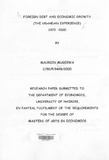| dc.contributor.author | Mugerwa, Maureen | |
| dc.date.accessioned | 2013-05-07T09:26:25Z | |
| dc.date.available | 2013-05-07T09:26:25Z | |
| dc.date.issued | 2004 | |
| dc.identifier.citation | Masters thesis University of Nairobi (2004) | en |
| dc.identifier.uri | http://erepository.uonbi.ac.ke:8080/xmlui/handle/123456789/19702 | |
| dc.description | Degree of Masters of Arts in Economics | en |
| dc.description.abstract | This paper analyses Uganda's external debt problem. Like many other
countries in the sub-Saharan Africa, Uganda is a severely indebted low -income country. Uganda's total debt stock at end June 1999 was estimated at US$2.64 billion, with a debt service ratio of nearly 80%.A look at Uganda's debt profile since the 1970's reveals a composition of debt
mainly from multilateral creditors. The study particularly links debt to
economic growth. A major observation is the acute debt-servicing
obligation of the country, and the fact that a large proportion of Uganda's
debt is not eligible for rescheduling, Debt payments have been a
fundamental cause of low economic growth. Of great concern whether the
economy can sustain it current growth rate of 5% per annum and at the
same time maintain adequate domestic investment, given the heavy
reliance on foreign import capital flows. Debt relief is not enough;
continued government commitment to structural reforms and sound debt
management are essential.
The need to continue the ongoing restructuring of the economy and
promote further growth is apparent But.how sustainable and possible is
the challenging path without accumulating more debt? | en |
| dc.language.iso | en | en |
| dc.publisher | University of Nairobi | en |
| dc.title | Foreign debt and economic growth (the Ugandan experience) 1970 -2000 | en |
| dc.type | Thesis | en |
| local.publisher | Department of Economics | en |

